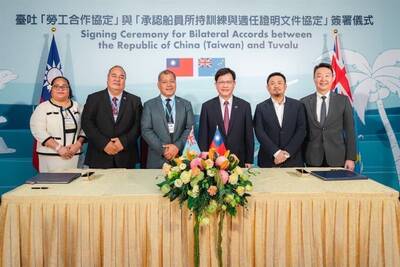The Chinese People’s Liberation Army (PLA) might conduct another distant-water carrier training drill by the end of this year, a military analyst said last week.
There are signs that China’s regional assertiveness is growing and its armed forces are becoming increasingly competent, said Jiang Hsinbiao (江炘杓), an assistant research fellow at Taiwan’s Institute for National Defense and Security Research.
In an analysis published on Wednesday last week, Jiang called attention to recent drills in the Western Pacific by the carrier group led by the Liaoning aircraft carrier.

Photo: Reuters
The carrier group left its home port of Qingdao on April 30, crossing the Miyako Strait, then entered the Western Pacific on May 2 for a series of training exercises, Jiang said.
After that, it entered the East China Sea on May 21 for joint sea and air drills, before returning to Qingdao on May 23, he said.
During the exercises, Shenyang J-15 fighter jets conducted the largest number of takeoffs and landings in a single day since the Liaoning was commissioned a decade ago, Jiang said.
The Shenyang jets carried out an average 15 sorties per day, which meant roughly 300 over the 20-day period, he said, adding that the aircraft were conducting nighttime and daytime training flights.
Considering the Liaoning is a medium-sized carrier equipped with only two elevators, that was a significant number of sorties, Jiang said.
While the battlegroup has carried out similar exercises in the past, the PLA focused mainly on command and coordination between the carrier and its escort vessels, which amounted to basic training, he said.
However, the exercises last month were large-scale drills carried out southeast of the Ryukyu Islands and east of Taiwan, with other PLA military units simulating enemy forces, Jiang said.
Xian H-6J strategic bombers, Y-8 anti-submarine aircraft and other PLA assets were involved in the exercises along with the Liaoning battlegroup, Jiang said.
To hone the combat-readiness of the Liaoning battlegroup, the PLA is likely to conduct a similar large-scale drill around the first island chain in the western Pacific by the end of the year, he said.

The Ministry of Economic Affairs has fined Taobao NT$1.2 million (US$36,912) for advertisements that exceed its approved business scope, requiring the Chinese e-commerce platform to make corrections in the first half of this year or its license may be revoked. Lawmakers have called for stricter enforcement of Chinese e-commerce platforms and measures to prevent China from laundering its goods through Taiwan in response to US President Donald Trump’s heavy tariffs on China. The Legislative Yuan’s Finance Committee met today to discuss policies to prevent China from dumping goods in Taiwan, inviting government agencies to report. Democratic Progressive Party Legislator Kuo Kuo-wen (郭國文) said

The Ministry of Economic Affairs has fined Taobao NT$1.2 million (US$36,900) for advertisements that exceeded its approved business scope and ordered the Chinese e-commerce platform to make corrections in the first half of this year or its license would be revoked. Lawmakers have called for stricter supervision of Chinese e-commerce platforms and more stringent measures to prevent China from laundering its goods through Taiwan as US President Donald Trump’s administration cracks down on origin laundering. The legislature’s Finance Committee yesterday met to discuss policies to prevent China from dumping goods in Taiwan, inviting government agencies to report on the matter. Democratic Progressive Party

Taiwan and its Pacific ally Tuvalu on Tuesday signed two accords aimed at facilitating bilateral cooperation on labor affairs, according to Taiwan’s Ministry of Foreign Affairs (MOFA). The governments inked two agreements in Taipei, witnessed by Foreign Minister Lin Chia-lung (林佳龍) and visiting Deputy Tuvaluan Prime Minister Panapasi Nelesone, MOFA said in a news release. According to MOFA, the agreements will facilitate cooperation on labor issues and allow the two sides to mutually recognize seafarers’ certificates and related training. Taiwan would also continue to collaborate with Tuvalu across various fields to promote economic prosperity as well as the well-being of their

Sung Chien-liang (宋建樑), who led efforts to recall Democratic Progressive Party (DPP) Legislator Lee Kun-cheng (李坤城), was released on bail of NT$80,000 today amid outcry over his decision to wear a Nazi armband to questioning the night before. Sung arrived at the New Taipei District Prosecutors’ Office for questioning in a recall petition forgery case last night wearing a red armband bearing a swastika, carrying a copy of Adolf Hitler’s Mein Kampf and giving a Nazi salute. Sung left the building at 1:15am without the armband and covering the book with his coat. Lee said today that this is a serious